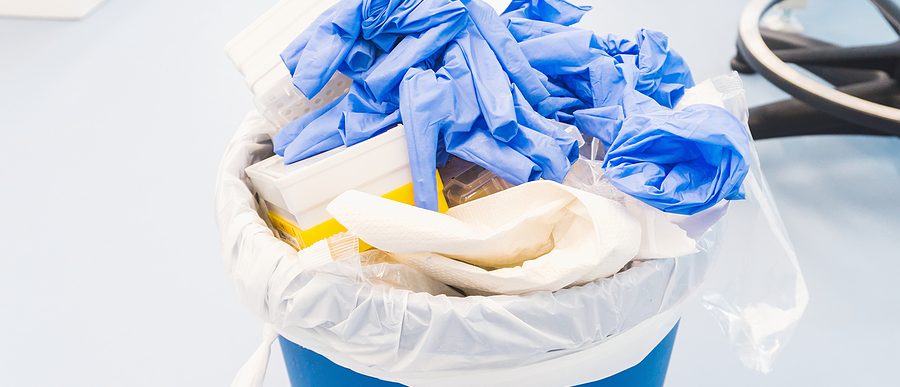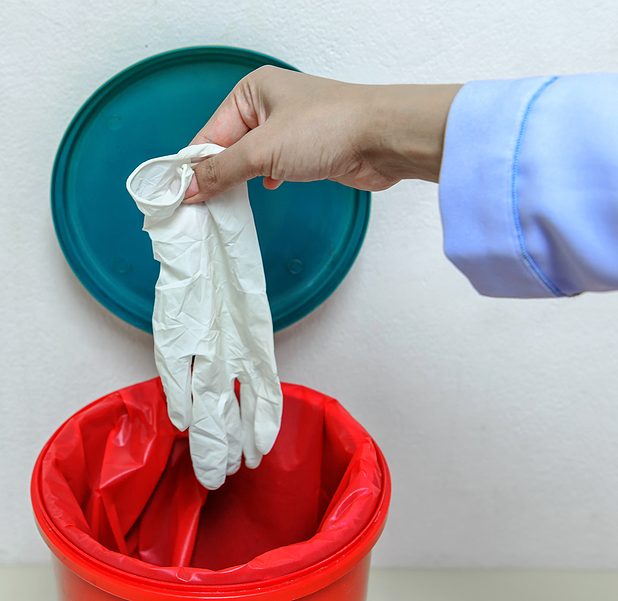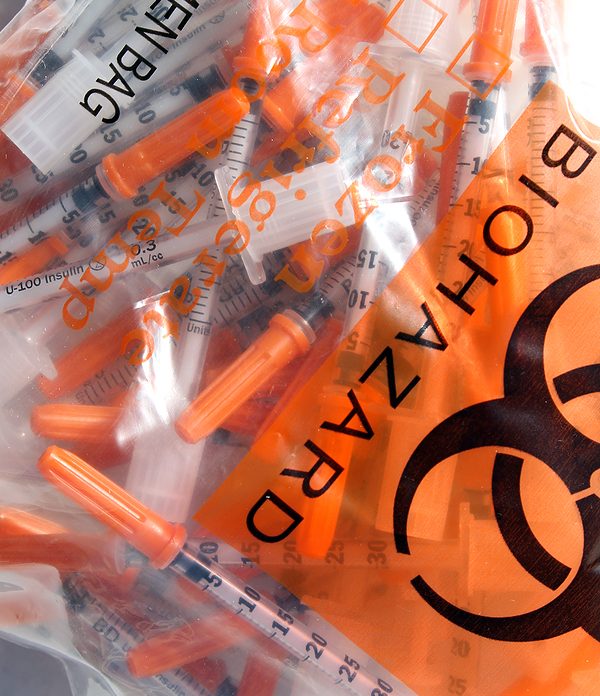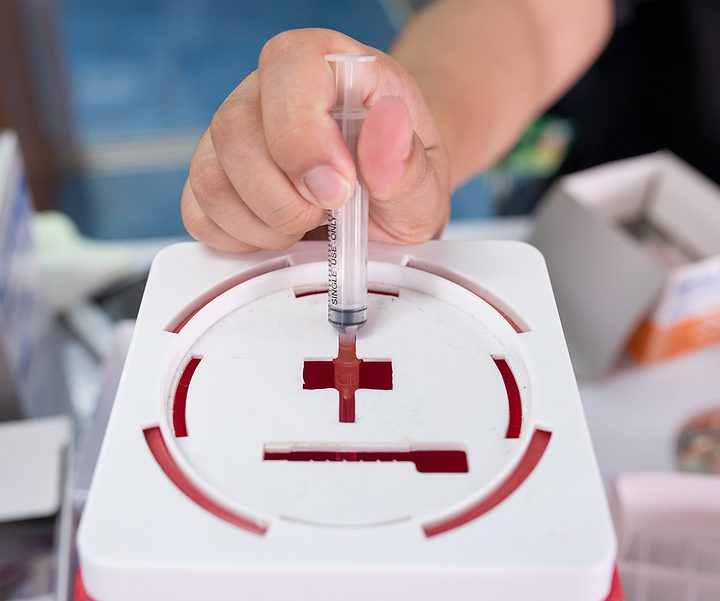Handling Healthcare Waste

Healthcare aims to protect against and treat illnesses and injuries. Different types of professionals in many areas of expertise can diagnose, care for, and treat ailments to benefit individuals and the community’s well-being. Healthcare waste is created during these activities, making it more likely to carry infection or cause injury than other types of waste. Because of the potential hazards, safe handling is essential to maintaining public health and protecting the environment.
What is Healthcare Waste?
Healthcare waste is any trash or disposable byproduct leftover from a healthcare activity. The World Health Organization (WHO) reports that 85% of healthcare waste is general, non-hazardous waste and the remaining 15% is hazardous materials that could be infectious, chemical, or radioactive.
Types of Healthcare Waste
General Waste: General waste is non-hazardous, similar to typical household or office waste. Examples include paper, food waste, plastic, etc.
Infectious waste: Infectious waste is contaminated by blood or other bodily fluids, cultures or stocks of infectious substances from lab work, and waste from people with infections. Examples include surgical waste, body parts and tissue, and blood cultures.
Hazardous Waste: Non-infectious waste that still has the potential to cause harm is considered hazardous. Hazardous waste is classified by Resource Conservation and Recovery Act (RCRA) guidelines. Examples include chemicals, chemotherapy agents, and sharps.
Sharps: Sharps are considered hazardous waste but must be collected and disposed of separately from other medical waste. Sharps include any medical object with a sharp point or edge that could cut skin. Examples include needles, lancets, and syringes.
Radioactive Waste: Radioactive waste is any medical item containing radioactive materials. Examples include cancer therapy waste, lab research liquids, and medical equipment using radioactive isotopes.
Pharmaceutical Waste: Pharmaceutical waste is unused, expired, or contaminated drugs or vaccines. Examples include pills, patches, and liquid medication.
Who Produces Healthcare Waste?
Healthcare waste is generated in many different settings. Hospitals and healthcare facilities produce the majority of medical waste, but other sources include:
- Laboratories, blood banks, and research centers
- Dental Offices
- Funeral Homes
- Pharmacies
- Veterinarian Offices
- Nursing Homes, Long Term Care, and Hospice
- Medical Spas
- Healthcare-related businesses
- Residential homes

What are the Risks of Healthcare Waste?
Healthcare waste poses several risks to human health and the environment. Waste materials may carry potentially harmful microorganisms that can infect patients, health workers, waste workers, and the general public. Other hazards include drug-resistant microorganisms that spread to the environment, injury and infection spread by sharps, and the release of toxic pollutants into the environment.
Untreated medical waste has been linked to the passing of HIV, Hepatitis B and C, parasitic infections, Tuberculosis, and more. Used sharps can cause injury and exposure to disease. Adverse health outcomes can also be caused by toxic exposure to pharmaceuticals, waterborne illness from pathogenic microbes in the water supply, and improper treatment of waste that causes chemical burns, radiation burns, and other thermal injuries.
Pollution from personal protective equipment (PPE) and excess plastic waste generated in healthcare facilities has reached a critical level. Single-use plastics make up nearly 20% of healthcare waste, yet recycling systems are often non-existent. PPE waste pollutes marine ecosystems and threatens human and wildlife health through the release of microplastics.
How healthcare waste is treated has a huge impact on the environment. Improper incineration releases human carcinogens and chemicals into the air. WHO recommends safer treatment methods including autoclaving, closed high-temperature incineration, and microwaving over open burning.
How to Safely Handle Healthcare Waste
Safe handling and disposal includes many steps and methods depending on the types of waste you are handling.
Step 1: Classification
Classifications are based on national regulations and international guidelines. Classifications help decide which treatment approaches work best and give clearer waste-minimization options.
Step 2: Segregation
Segregation separates different types of waste so it can be disposed of more effectively. Separating hazardous from non-hazardous waste also reduces the volume of waste that requires specialized treatment, saving money for your facility.
Step 3: Handling & Collection
Safe waste handling should be established as part of your healthcare waste management plan. It should cover the use of proper PPE, safe body mechanics (to protect against injury), and special handling based on the type of waste.
A safe collection system identifies the point of generation for different types of waste, identifies proper containers and container sizes for each area, evaluates how quickly containers will fill, and sets up collection times to ensure that containers are not overfilled. Waste should be labeled based on content and include the date, type of waste, and the point of generation for tracking purposes.
Step 4: Storage & Transportation
Healthcare facilities should have a central storage site for the safe retention of healthcare waste until it is treated or collected for transportation offsite. Storage sites should have a well-drained, easy-to-clean floor; a water supply for cleaning; secured entry; be well-lit and ventilated; and be free of insect and rodent infestation. If interim storage is needed, a locked utility room or another designated locked location can be used.
Transportation on site should take place during less busy times, using set routes to prevent unwanted exposure. Hazardous and non-hazardous waste should be transported separately. Transportation equipment should be able to contain leaks and be disinfected daily. Offsite transportation should be carried out by a licensed and authorized carrier.
Step 5: Treatment & Disposal
Waste treatment reduces the potential hazards posed by medical waste. There are five basic processes used to treat hazardous, infectious, and pathological waste:
- Thermal Treatment – This treatment uses heat to destroy pathogens. There are high-heat and low-heat options. Examples of thermal treatment are autoclaving, hybrid steam systems, microwave units, frictional heat treatment, and dry heat systems.
- Chemical Treatment – This treatment uses chemical disinfectants and often includes shredding, grinding, or mixing to increase the chemical exposure. An example of a chemical treatment is alkaline hydrolysis.
- Irradiation Process – This treatment used electron beams, Cobalt-60, or ultraviolet sources to destroy pathogens. It requires high investment costs and is not typically used.
- Biological Treatment Process – This process uses natural degradation including composting, vermiculture, biodigestion, and natural decomposition to dispose of cadavers, tissues, and anatomical parts. Enzymes can be added to speed up the process.
- Mechanical Process – Mechanical methods are utilized after waste has been disinfected to supplement other treatment methods. Shredding, grinding, mixing, and compaction improve heat transfer and reduce waste volume.

Once healthcare waste is sterilized or decontaminated to a high disinfection level, it can be discarded with regular waste in a landfill.
What is a Waste Management Policy?
Healthcare waste management should address the risks of medical waste while promoting practices to reduce the volume of waste generated. A waste management policy addresses collecting, treating, recycling, and disposing of waste materials to reduce health risks and environmental impact. The process for creating a waste management policy can include:
- A waste assessment and evaluation of existing practices
- Evaluation of waste management options
- Development of a waste management plan
- Account for the legal and regulatory framework for healthcare waste management Statement of institutional policies and guidelines
- Budgeting resources and staff requirements
- Training programs
- Continuous monitoring and evaluation for improvement


Your waste management policy should, at minimum, contain the following sections:
- Current waste management practices
- The quantities of waste generated
- Waste segregation
- Onsite handling and storage practices
- Transportation practices
- Waste minimization strategies
- Waste treatment and disposal options
- Record keeping and documentation
- Training and monitoring
- Budget and cost estimation
- Strategies for implementing your waste management plan
Healthcare Waste Disposal Services
Medical Waste Pros offers waste management services for healthcare facilities, laboratories, and other healthcare facilities. We have a network of professionals with the expertise and resources to handles all types of healthcare waste. We offer:
Regularly Scheduled Pickups
Scheduled pickups safely dispose of your medical waste on a schedule that aligns with your waste generation. We can create a schedule that works for you whether it is daily, weekly, monthly, or quarterly.
On-Call Pickups
On-call pickups are ideal for facilities that don’t require regular pickups or for emergencies. The service is the same as scheduled pickups but can be scheduled whenever they are needed.
Mail-Back Services
Mail-back services are an efficient way to collect, return, and dispose of your healthcare waste. The system provides everything you will need to package your waste and send it in for safe disposal. This option is best for small-scale waste generators.
Safely Handle Your Healthcare Waste with Medical Waste Pros
Safely handling your healthcare waste protects your patients, staff, and the community. Medical Waste Pros will instantly match you with a waste disposal provider that offers secure options in your area. Our services are affordable, reliable, and eco-friendly. We guarantee the efficient and safe removal of healthcare waste that is compliant with all relevant regulations.
Contact us by calling (888) 755-6370 or fill out the form to receive free quotes today. Our experts are happy to answer any questions and suggest the best services to meet your needs.










